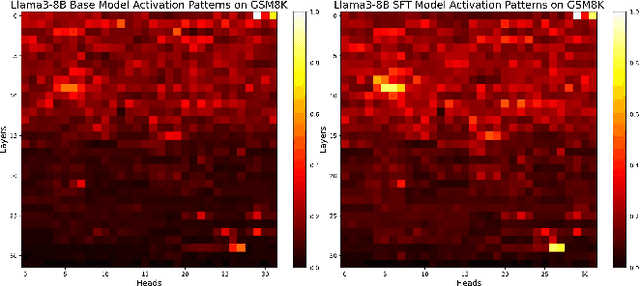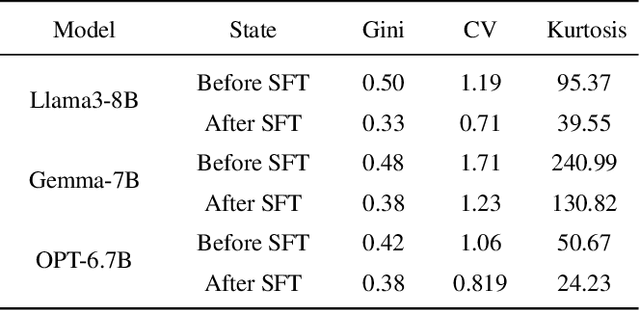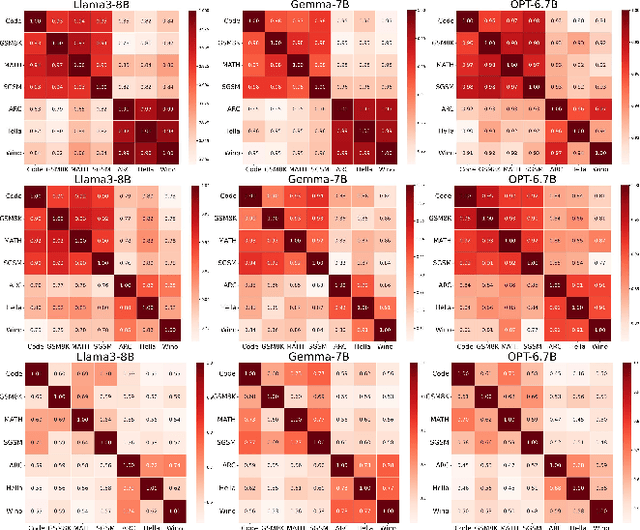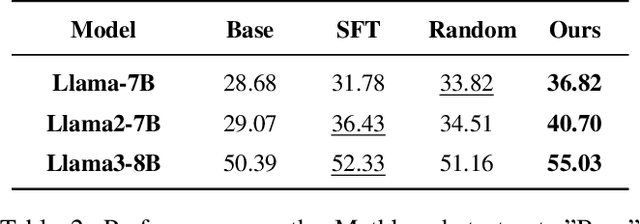Kai Xiong
Do LLMs Signal When They're Right? Evidence from Neuron Agreement
Oct 30, 2025Abstract:Large language models (LLMs) commonly boost reasoning via sample-evaluate-ensemble decoders, achieving label free gains without ground truth. However, prevailing strategies score candidates using only external outputs such as token probabilities, entropies, or self evaluations, and these signals can be poorly calibrated after post training. We instead analyze internal behavior based on neuron activations and uncover three findings: (1) external signals are low dimensional projections of richer internal dynamics; (2) correct responses activate substantially fewer unique neurons than incorrect ones throughout generation; and (3) activations from correct responses exhibit stronger cross sample agreement, whereas incorrect ones diverge. Motivated by these observations, we propose Neuron Agreement Decoding (NAD), an unsupervised best-of-N method that selects candidates using activation sparsity and cross sample neuron agreement, operating solely on internal signals and without requiring comparable textual outputs. NAD enables early correctness prediction within the first 32 generated tokens and supports aggressive early stopping. Across math and science benchmarks with verifiable answers, NAD matches majority voting; on open ended coding benchmarks where majority voting is inapplicable, NAD consistently outperforms Avg@64. By pruning unpromising trajectories early, NAD reduces token usage by 99% with minimal loss in generation quality, showing that internal signals provide reliable, scalable, and efficient guidance for label free ensemble decoding.
PuzzleClone: An SMT-Powered Framework for Synthesizing Verifiable Data
Aug 21, 2025Abstract:High-quality mathematical and logical datasets with verifiable answers are essential for strengthening the reasoning capabilities of large language models (LLMs). While recent data augmentation techniques have facilitated the creation of large-scale benchmarks, existing LLM-generated datasets often suffer from limited reliability, diversity, and scalability. To address these challenges, we introduce PuzzleClone, a formal framework for synthesizing verifiable data at scale using Satisfiability Modulo Theories (SMT). Our approach features three key innovations: (1) encoding seed puzzles into structured logical specifications, (2) generating scalable variants through systematic variable and constraint randomization, and (3) ensuring validity via a reproduction mechanism. Applying PuzzleClone, we construct a curated benchmark comprising over 83K diverse and programmatically validated puzzles. The generated puzzles span a wide spectrum of difficulty and formats, posing significant challenges to current state-of-the-art models. We conduct post training (SFT and RL) on PuzzleClone datasets. Experimental results show that training on PuzzleClone yields substantial improvements not only on PuzzleClone testset but also on logic and mathematical benchmarks. Post training raises PuzzleClone average from 14.4 to 56.2 and delivers consistent improvements across 7 logic and mathematical benchmarks up to 12.5 absolute percentage points (AMC2023 from 52.5 to 65.0). Our code and data are available at https://github.com/puzzleclone.
Com$^2$: A Causal-Guided Benchmark for Exploring Complex Commonsense Reasoning in Large Language Models
Jun 08, 2025Abstract:Large language models (LLMs) have mastered abundant simple and explicit commonsense knowledge through pre-training, enabling them to achieve human-like performance in simple commonsense reasoning. Nevertheless, LLMs struggle to reason with complex and implicit commonsense knowledge that is derived from simple ones (such as understanding the long-term effects of certain events), an aspect humans tend to focus on more. Existing works focus on complex tasks like math and code, while complex commonsense reasoning remains underexplored due to its uncertainty and lack of structure. To fill this gap and align with real-world concerns, we propose a benchmark Com$^2$ focusing on complex commonsense reasoning. We first incorporate causal event graphs to serve as structured complex commonsense. Then we adopt causal theory~(e.g., intervention) to modify the causal event graphs and obtain different scenarios that meet human concerns. Finally, an LLM is employed to synthesize examples with slow thinking, which is guided by the logical relationships in the modified causal graphs. Furthermore, we use detective stories to construct a more challenging subset. Experiments show that LLMs struggle in reasoning depth and breadth, while post-training and slow thinking can alleviate this. The code and data are available at https://github.com/Waste-Wood/Com2.
Self-Route: Automatic Mode Switching via Capability Estimation for Efficient Reasoning
May 27, 2025Abstract:While reasoning-augmented large language models (RLLMs) significantly enhance complex task performance through extended reasoning chains, they inevitably introduce substantial unnecessary token consumption, particularly for simpler problems where Short Chain-of-Thought (Short CoT) suffices. This overthinking phenomenon leads to inefficient resource usage without proportional accuracy gains. To address this issue, we propose Self-Route, a dynamic reasoning framework that automatically selects between general and reasoning modes based on model capability estimation. Our approach introduces a lightweight pre-inference stage to extract capability-aware embeddings from hidden layer representations, enabling real-time evaluation of the model's ability to solve problems. We further construct Gradient-10K, a model difficulty estimation-based dataset with dense complexity sampling, to train the router for precise capability boundary detection. Extensive experiments demonstrate that Self-Route achieves comparable accuracy to reasoning models while reducing token consumption by 30-55\% across diverse benchmarks. The proposed framework demonstrates consistent effectiveness across models with different parameter scales and reasoning paradigms, highlighting its general applicability and practical value.
UFO-RL: Uncertainty-Focused Optimization for Efficient Reinforcement Learning Data Selection
May 18, 2025Abstract:Scaling RL for LLMs is computationally expensive, largely due to multi-sampling for policy optimization and evaluation, making efficient data selection crucial. Inspired by the Zone of Proximal Development (ZPD) theory, we hypothesize LLMs learn best from data within their potential comprehension zone. Addressing the limitation of conventional, computationally intensive multi-sampling methods for data assessment, we introduce UFO-RL. This novel framework uses a computationally efficient single-pass uncertainty estimation to identify informative data instances, achieving up to 185x faster data evaluation. UFO-RL leverages this metric to select data within the estimated ZPD for training. Experiments show that training with just 10% of data selected by UFO-RL yields performance comparable to or surpassing full-data training, reducing overall training time by up to 16x while enhancing stability and generalization. UFO-RL offers a practical and highly efficient strategy for scaling RL fine-tuning of LLMs by focusing learning on valuable data.
Joint Resource Estimation and Trajectory Optimization for eVTOL-involved CR network: A Monte Carlo Tree Search-based Approach
Apr 25, 2025Abstract:Electric Vertical Take-Off and Landing (eVTOL) aircraft, pivotal to Advanced Air Mobility (AAM), are emerging as a transformative transportation paradigm with the potential to redefine urban and regional mobility. While these systems offer unprecedented efficiency in transporting people and goods, they rely heavily on computation capability, safety-critical operations such as real-time navigation, environmental sensing, and trajectory tracking--necessitating robust offboard computational support. A widely adopted solution involves offloading these tasks to terrestrial base stations (BSs) along the flight path. However, air-to-ground connectivity is often constrained by spectrum conflicts with terrestrial users, which poses a significant challenge to maintaining reliable task execution. Cognitive radio (CR) techniques offer promising capabilities for dynamic spectrum access, making them a natural fit for addressing this issue. Existing studies often overlook the time-varying nature of BS resources, such as spectrum availability and CPU cycles, which leads to inaccurate trajectory planning, suboptimal offloading success rates, excessive energy consumption, and operational delays. To address these challenges, we propose a trajectory optimization framework for eVTOL swarms that maximizes task offloading success probability while minimizing both energy consumption and resource competition (e.g., spectrum and CPU cycles) with primary terrestrial users. The proposed algorithm integrates a Multi-Armed Bandit (MAB) model to dynamically estimate BS resource availability and a Monte Carlo Tree Search (MCTS) algorithm to determine optimal offloading decisions, selecting both the BSs and access time windows that align with energy and temporal constraints.
Digital Twin-based SIM Communication and Flight Control for Advanced Air Mobility
Jan 03, 2025



Abstract:Electric Vertical Take-off and Landing vehicles (eVTOLs) are driving Advanced Air Mobility (AAM) toward transforming urban transportation by extending travel from congested ground networks to low-altitude airspace. This transition promises to reduce traffic congestion and significantly shorten commute times. To ensure aviation safety, eVTOLs must fly within prescribed flight corridors. These corridors are managed by ground-based Air Traffic Control (ATCo) stations, which oversee air-ground communication and flight scheduling. However, one critical challenge remains: the lack of high rate air-ground communication and safe flight planning within these corridors. The introduction of 6G-oriented Stacked Intelligent Metasurface (SIM) technology presents a high rate communication solution. With advanced phase-shifting capabilities, SIM enables precise wireless signal control and supports beam-tracking communication with eVTOLs. Leveraging this technology, we propose a Composite Potential Field (CPF) approach. This method dynamically integrates target, separation, and communication fields to optimize both SIM communication efficiency and flight safety. Simulation results validate the effectiveness of this DT-based approach. Compared to the potential field flight control benchmark, it improves the transmission rate by 8.3\%. Additionally, it reduces flight distance deviation from the prescribed corridor by 10\% compared to predetermined optimization methods.
Efficient and Accurate Prompt Optimization: the Benefit of Memory in Exemplar-Guided Reflection
Nov 12, 2024



Abstract:Automatic prompt engineering aims to enhance the generation quality of large language models (LLMs). Recent works utilize feedbacks generated from erroneous cases to guide the prompt optimization. During inference, they may further retrieve several semantically-related exemplars and concatenate them to the optimized prompts to improve the performance. However, those works only utilize the feedback at the current step, ignoring historical and unseleccted feedbacks which are potentially beneficial. Moreover, the selection of exemplars only considers the general semantic relationship and may not be optimal in terms of task performance and matching with the optimized prompt. In this work, we propose an Exemplar-Guided Reflection with Memory mechanism (ERM) to realize more efficient and accurate prompt optimization. Specifically, we design an exemplar-guided reflection mechanism where the feedback generation is additionally guided by the generated exemplars. We further build two kinds of memory to fully utilize the historical feedback information and support more effective exemplar retrieval. Empirical evaluations show our method surpasses previous state-of-the-arts with less optimization steps, i.e., improving F1 score by 10.1 on LIAR dataset, and reducing half of the optimization steps on ProTeGi.
Supervised Fine-Tuning: An Activation Pattern Optimization Process for Attention Heads
Sep 24, 2024



Abstract:Though demonstrating promising potential, LLMs' performance on complex tasks, such as advanced mathematics and complex disease diagnosis is still unsatisfactory. A key issue is the present LLMs learn in a data-driven schema, while the instruction dataset about these complex tasks is both scarce and hard to collect or construct. On the contrary, a prominent phenomenon is that LLMs can learn rather fast on those simpler tasks with adequate prior knowledge captured during pretraining stage. Thus, if the prerequisite and mechanism of such rapid generalization could be elucidated, it could be highly beneficial in enhancing the efficiency and effectiveness of the LLM's ability to learn complex tasks. Thus, in this paper, we employ a gradient-based method, to dissect the process that the SFT process adapts LLMs to downstream tasks via the perspective of attention patterns. We find that: (1) LLMs selectively activate task-specific attention heads during SFT; (2) activation patterns for complex tasks are combinations of basic task patterns; and (3) changes in a few parameters can significantly impact activation patterns after SFT on a small number of samples. Based on these insights, we conduct experiments to examine whether these conclusions could effectively enhance the efficiency and effectiveness of SFT, particularly in handling complex tasks and when instructional resources are scarce. Our research not only uncovers the underlying reasons behind LLMs' rapid learning and generalization mechanisms but also provides practical solutions for addressing data challenges in complex and specialized tasks.
Diagnosing and Remedying Knowledge Deficiencies in LLMs via Label-free Curricular Meaningful Learning
Aug 21, 2024



Abstract:Large Language Models (LLMs) are versatile and demonstrate impressive generalization ability by mining and learning information from extensive unlabeled text. However, they still exhibit reasoning mistakes, often stemming from knowledge deficiencies, which can affect their trustworthiness and reliability. Although users can provide diverse and comprehensive queries, obtaining sufficient and effective feedback is demanding. Furthermore, evaluating LLMs comprehensively with limited labeled samples is difficult. This makes it a challenge to diagnose and remedy the deficiencies of LLMs through rich label-free user queries. To tackle this challenge, we propose a label-free curricular meaningful learning framework (LaMer). LaMer first employs relative entropy to automatically diagnose and quantify the knowledge deficiencies of LLMs in a label-free setting. Next, to remedy the diagnosed knowledge deficiencies, we apply curricular meaningful learning: first, we adopt meaningful learning to adaptively synthesize augmentation data according to the severity of the deficiencies, and then design a curricular deficiency remedy strategy to remedy the knowledge deficiencies of LLMs progressively. Experiments show that LaMer efficiently and effectively diagnoses and remedies knowledge deficiencies in LLMs, improving various LLMs across seven out-of-distribution (OOD) reasoning and language understanding benchmarks, achieving comparable results to baselines with just 40\% training data. LaMer even surpasses methods that rely on labeled datasets for deficiency diagnosis. In application, our label-free method can offer an effective knowledge deficiency diagnostic tool for efficient LLM development.
 Add to Chrome
Add to Chrome Add to Firefox
Add to Firefox Add to Edge
Add to Edge